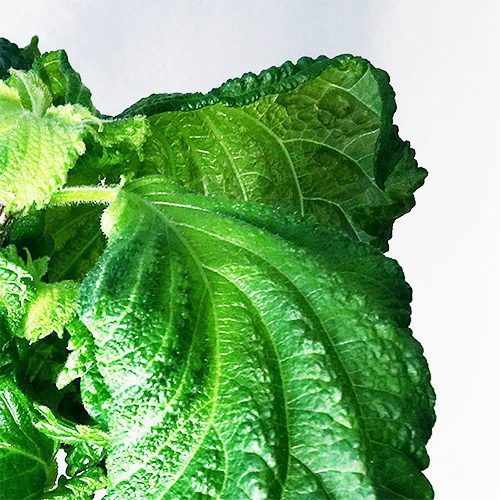Shiso
Latin name: Perilla frutescens var. crispa
🌱 Days to Sprout: 7-14
😋 Ready for Full Dose of plant food with true leaves or roots .5-inch long
✂️ Thin to: 3 plants per yCube
🍅 Days to Maturity: 50-60
💡 Light Zone: Medium
📏 Plant Size: 1 ft
💚 Care Level: Intermediate
Origin
Technically a member of the mint family native to China and India, Shiso is an aromatic herb that is a long-standing staple of Chinese herbal medicine. Its English name is the same as its Japanese name, where the plant is beloved in sushi, noodles, salads, and rice dishes.
Qualities
Shiso is broad-leafed herb with a similar growth habit as basil. It does well in warmer climates, making it an excellent choice for your summer Gardyn! The broad leaves have a bold, complex flavor that combines savory cumin, pepper, and nutmeg with lighter herbal notes of mint and anise.
Use
Shiso leaves are best used fresh. A little can go a long way, so experiment to learn how much flavor you like! Add to salads, hearty pastas, noodles, or rice dishes. Shiso is also a good substitute for basil or mint in most recipes.
Care & Harvest
✂️ Pruning: Remove leaves with brown spots if they appear. Check the roots monthly and trim any that are brown or extending past the yPod. To encourage bushier rather than taller growth, you can “top” the plant by pruning its main growth tip on each stem at the desired new height. Remove flower buds as they appear to delay bolting and encourage more leaf production.
🌿 Harvest: Harvesting frequently helps prolong the plant's life. The leaves can be harvested individually, or by the stem. You can begin harvesting when young, as long as you leave ⅓ of the leaves behind to let the plant continue growing.
Harvest to Plate Recipe
Ume Shiso Pasta
Recipe Source: Just One Cookbook
Ingredients
8 oz spaghetti
10-20 shiso leaves
2 cloves garlic
½ shimeji mushrooms
2 umeboshi (Japanese pickled plum)
4 chicken tenders (pre-cut)
¼ tsp kosher/sea salt
freshly ground black pepper
1 Tbsp all-purpose flour
2 Tbsp extra-virgin olive oil (1 Tbsp for non stick pan)
1 Tbsp soy sauce
¼ cup shredded nori seaweed (kizami nori)
Instructions
Cook spaghetti 1 minute fewer than the package instructions in lightly salted boiling water. Reserve about ½ cup of pasta cooking water before you drain the spaghetti into a colander.
Meanwhile, roll up shiso leaves and julienne into thin strips.
Slice garlic and discard the bottom part of buna shimeji mushrooms.
Remove the seed from umeboshi and discard. Then mince into small pieces.
Slice the chicken tender diagonally into 1-inch pieces (this cutting technique is called “Sogigiri”). Sprinkle with salt and pepper.
Sprinkle the flour over the chicken and coat it well with your hands.
Heat the olive oil on medium-high heat and cook garlic until fragrant.
Add the chicken and cook until no longer pink. Then cook the shimeji mushrooms till coated with oil.
Add ¼ cup of the pasta cooking water, soy sauce, and umeboshi.
When the chicken is coated with the sauce, add the spaghetti into the pan. Using a tong, coat the spaghetti well with the sauce. If you need more sauce, add the pasta cooking water and soy sauce and adjust the flavor. Season with salt and freshly ground black pepper to your taste.
Garnish with shiso leaves and shredded nori on top.
Our Plant Health & Nutrition Team thoroughly tests each variety we offer to bring you the most flavorful and high-quality plants. We regularly rotate our plant portfolio, so please note, availability varies.

